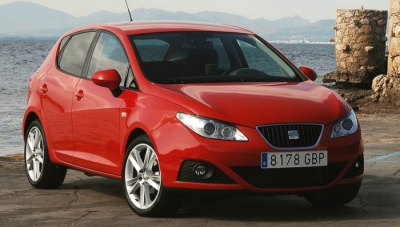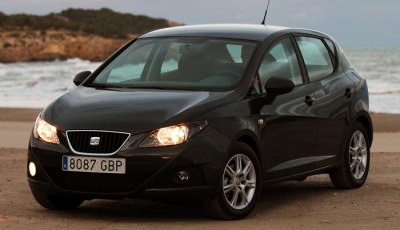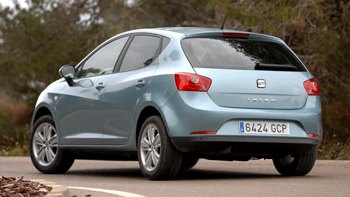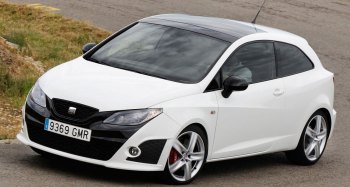|
SEAT Ibiza
Debut: 2008
Maker: SEAT
Predecessor: Ibiza (2001) |
|

|
Luc Donckerwolke brings life to the
new design...
|
The
last generation Seat
Ibiza was hardly outstanding among European B-segment hatchbacks. This
time with the service of ex-Lamborghini designer Luc Donckerwolke, it
has a much better chance of getting our favour. Although Donckerwolke
did not break the mold of conventional small cars, he makes the new
Ibiza much more stylish than the going car as well as most rivals on
the market. Key features include muscular fenders, the flanks over the
bonnet and the crisp crease lines running from the sides towards the
trapezoidal bumper intake. They make the otherwise conventional profile
more interesting to eyes. Good styling make a difference!

|
Volkswagen's PQ25 platform makes debut
in this car |
Another goodies of the new Ibiza is
the new Volkswagen group
PQ25 platform lying underneath its sheet metal. This is the first debut
of PQ25, well before the next generation Volkswagen Polo, Audi A1 and
Skoda Fabia. Although its layout is predictable – front-drive, strut
and torsion-beam suspensions, electrical power steering etc. – there
are some refinements to its design to improve comfort, safety and
dynamics. To name a few, the front suspensions are now mounted on
subframes to reduce noise and harshness, and 60 percent of the chassis
by weight is made of high-strength steel.

|
Seat is supposed to be sportier than
sisters, but new Ibiza cares more about comfort...
|
From its sporty appearance and the
sport-biased market
positioning of the Seat brand, we expected the new Ibiza to be a sporty
drive. However, on the road it surprises many for offering a supple
ride. Road noise is also well suppressed. On the other hand, its
handling is faithful without revealing any sharp edges. Just like most
Volkswagen group products, it is grippy, well controlled and safe to
steer. But it is not especially exciting. A sharper and more
communicative steering could have earned it higher respect, as is a set
of stiffer springs. Well, Seat may leave that task for the 3-door
Ibiza, FR and Cupra models to fulfill. Still, we are disappointed that
from driving dynamics there is little to distinguish the Seat from
Volkswagen, if not the softer Skoda.

|
The handling of this car is good, just
not as good as its sporty image suggested...
|
Don’t get me wrong, the handling of
this car is good, just
not as good as its sporty image suggested. What really goes below the
class standard are its engines. When it was unveiled to the public in
March, I was surprised to hear its initial engine lineup consists of
all the outdated engines from Volkswagen’s parts pool, which include
the 69hp 1.2-liter 3-pot 12V, 86hp 1.4-liter 16V and 105hp 1.6-liter
16V petrol. No downsized turbocharged engines (where is Volkswagen’s
famous 1.4 TFSI and Twincharger?), no direct injection, no variable
valve timing… Diesel engine is the 105hp pump-injection 1.9TDI, to be
phased out soon. These powerplants are either gutless or noisy at upper
rev, and they are not too frugal. I understand that Volkswagen group
usually reserves the first-hand new technology to its premium brands
and leaves the bread-and-butter brands to clear the stocks of old
mechanicals. However, customers do not care about corporate strategies.
What they ask for are some great engines to supplement the sporty
design and good chassis.

|
Spartin is the name of its interior
design...
|
Another disappointing area is the
interior. Here again,
Spartan is the name of its interior design. Materials and assembly
quality are much improved over the old car, but that doesn’t speak
much. Cabin room has no complaints, actually quite spacious.
As seen, the new Ibiza is not yet in the league of Opel Corsa and Fiat
Grande Punto. (BTW, I suspect the new Ford Fiesta will have them beaten
again) Nevertheless, by introducing newer engines and by offering
sportier models, it seems to me that most of its problems could be
solved easily. By then Volkswagen group will have another strong card
on hand.
|
| The
above report was last updated on 19 May 2008. All Rights Reserved. |
|
FR, Cupra and Bocanegra
|

|
FR can be available in 5-door or
SportCoupe form as shown here.
|
Small
hot hatches are
attractive
to young male drivers. Not only cheap to buy and run, they deliver a
bland of performance and agility that is just perfect to exploit on
B-roads. European superminis have long been dominating this segment.
Most of them offer not only one, but two states of tune to cover this
broad segment. For example, Fiat has Grande Punto Abarth (155hp) and SS
(180hp), Mini has Cooper (120hp) and Cooper S (175hp), Opel has Corsa
GSi (150hp) and OPC (192hp), Peugeot has 207GT (150hp) and RC (175hp),
Renault has Clio GT (128hp) and RS (200hp). So you can choose between
them depending on your budget and enthusiastic level.
Comparatively, Volkswagen group is not so keen on small hot hatches.
Among its 3 mainstream brands - Volkswagen, Skoda and SEAT - only the
latter is really devoted into this segment. As a brand targeting at
young male drivers, how could have SEAT miss it ? The Spanish company
offers 3 models for its customers to select: FR, Cupra and Bocanegra.
In fact, there are only two, because Bocanegra is actually an optional
styling kits that you can purchase on the other two models. Bocanegra
means "black mouth", which is obvious in the car's appearance. It also
adds a wider air dam, a fake central exhaust and faux carbon-fiber
interior trim. As before, FR is the entry-level warm hatch and Cupra is
the really hot model. The Cupra is available only in 3-door
(SportCoupe) form while FR is also available in 5-door form. All of
them get the beautiful treatment of Luc Donckerwolke.

|
Cupra is unexpectedly matured in the
way it runs and corners...
|
Stylish aside, the duo are also unexpectedly sophisticated. Volkswagen
generously lends its renowned 1.4 TSI twin-charger engine and 7-speed
DSG twin-clutch gearbox - and the latter is standard here. Remember the
last generation FR and Cupra needed a 1.8 turbo engine to realize 150hp
and 180hp respectively? The new cars produce identical horsepower with
a 1390 cc engine, thanks to direct-injection and the combination of
supercharger and turbocharger. This result in vastly improved frugality
and emission. The supercharger works right from idle to 2400 rpm, by
then the turbocharger starts spooling up and completely takes over from
3500 rpm upward. No wonder its power delivery is so smooth and
completely free of lag. The FR engine has a nearly flat torque curve,
with a maximum 162 lb-ft available continuously from 1250 to 4500 rpm.
The Cupra engine runs a higher boost pressure at higher rev. From a
little over 5000 rpm there is a noticeable boost in power until the
7200 rpm limiter is reached. Both engines are delightedly free-revving
and refined.
The 7-speed DSG gearbox is also a masterpiece, easing your effort and
smoothing out the gearchanges. You can control through the conventional
gearstick or the paddles behind the steering wheel, so anyone will find
it intuitive to use. In auto mode it works like an automatic gearbox,
which is perfect for those regularly drive in urban area. The only
downside of the box is that it automatically upshifts when the rev
counter hits 7200 rpm in order to protect the engine, even in manual
mode. This takes away some driving pleasure.

|

|
|
| Bocanegra has a black mask |
|
|
The Cupra can top 140 mph and does 0-60 mph in 6.8 seconds, right in
the heartland of its segment. FR is not much slower, with 132 mph top
speed and 0-60 taking half a second longer. However, the most special
is the matured way it delivers its performance, which is a sharp
contrast to the rawer, more exciting and more traditional way of rivals
like Renault Clio RS, and Fiat Punto Abarth SS.
The ride and handling of both cars show a similar maturity. They offer
high level of grip, good body control and fine damping on back roads.
Volkswagen's XDS electronic differential - which simulates a limited
slip differential by applying braking to individual front wheels to
contain wheel spin in tight cornering - is effective to tidy up its
handling in extreme maneuver. In the Cupra you can get some fun by
oversteering it if you brake or back off throttle mid-corner, although
it is never as flickable as Clio RS. Compared with the standard 3-door
Ibiza SportCoupe, Cupra has a 10 mm drop in ride height, stiffer
springs, dampers and suspension bushings to achieve the aforementioned
improvement without destroying ride comfort. FR gets only 5 mm drop in
ride height. Its springs are 15 percent softer than the Cupra and the
front ventilated brake discs are smaller in size (288mm vs 312mm).
Nevertheless, the difference in handling is small. Both cars are
unexpectedly refined and easy to live with.
The problem is, under the aggressive looks, the FR and especially Cupra
are too well-mannered for what we expect from SEAT. In fact, mask its
appearance and judge it purely from its driving manner and you may
easily confuse it with a Volkswagen hot hatch. If SEAT wants to
distinguish it from the forthcoming Polo GTi, it should add more chili
to its character.
|
| The
above report was last updated on 5 Jul 2009. All Rights Reserved. |
|
|











